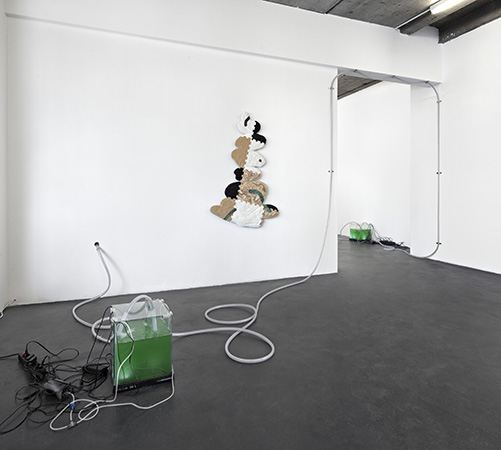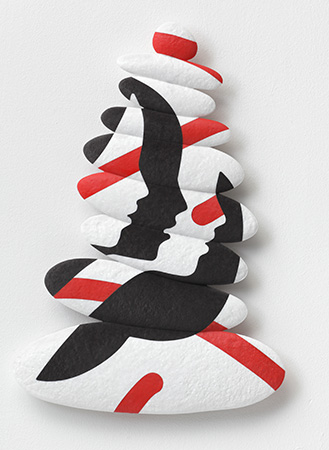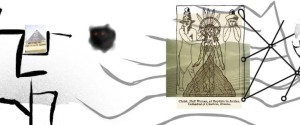Even without initial comprehension of the words rendered on a wall, the internet aesthetic Daniel Keller employs in Kai ♥ Dalston Bushwick is instantly clear. In the solo exhibition, running from May 1 to July 4, the warped curves of a hung sculptural piece called ‘Composite Career Captcha (Betterneties)’ (2015) are sampled from a captcha compound of ‘better’ and ‘eternities’. Captchas are online security devices meant to distinguish between human and machine users. In this sense, they isolate a specifically human capacity for visual perception while divorcing it from meaning. This vague sensation of recognition separate from understanding seems continuously generated throughout the show.

In the first room, grey hoses lead out of a tank of water, green bubbles consistently bursting on its murky surface. One hose trails into the adjoining room and another disappears through a hole drilled into the wall. The tanks of ‘Onanet Spirulina 1’ (2015) are three in total and each contain the rapidly reproducing Spirulina algae. Currently considered a superfood, the organism is harvested and distributed on the health food market in powdered and pill form. Although these hoses circulate the water from tank to tank, this process is meanwhile superfluous for the production of the algae. Rather, the web formed here appears to delve deeper into the idea of connection in general. With the ever growing increase of (particularly technical) global interconnection, a question arises: is it really necessary?
In plastic sleeves on the sill of the gallery window is an excerpt from the play iDRIVE, co-written by Keller and Ella Plevin. Acting in a sense as the basis for the rest of the show, the play follows a romance between the fictional daughter of Facebook founder Mark Zuckerberg and the offspring siblings of Ashton Kutcher: Kai, Dalston, and Bushwick, respectively. In the sections provided, the former two drive along an exaggerated future-scape of hyper-technologized North America. Inspired by Albert O. Hirschman’s Exit, Voice, and Loyalty, the conversations of iDRIVE span the potentials of leaving or staying within the techno-political economy via the vessels of Kai and Dalston.

Having walked through the two rooms once, I return to do another round, feeling the pieces fall together in the context of the play. For example, the three ‘Stack Relief’ (2015) structures resembling rock sculptures hanging on the walls are now extended in their meaning. On the one hand they allude to a past of basic environmental alteration and interactive creation. On the other, they are composed of complex assortments of materials (plywood, MDF, patinated brass, acrylic, aluminum, and sandstone, to name a few) and are incredibly artificial. From a distance, you note the diverse elements making up the patterned shapes of the object. Close up, they seem bound again, as though the entirety is made of plastic and stickered with design. The list detailing the pieces reconfirms the initial impression of diversity. Simple, complex, unified, divided – the past, the present, the past taken up by a present drawn into rapid future developments – it’s dizzying.
Like the ultimately unnecessary placement of the tubes connecting the tanks through the space, the assortment of works subsist within an internal, possibly also needless, logic. Although this logic is not immediately or inevitably understandable, it is simultaneously familiar in a rudimentary sense – perhaps acting in function similar to captchas, or the stone sculpture designs. You enter and you recognize, even if you cannot pin the meaning or extended complexity down to something that provides a deeper satisfaction. And at this stage, maybe there is a choice: you can go with it unwittingly, or comment, or leave. **
















